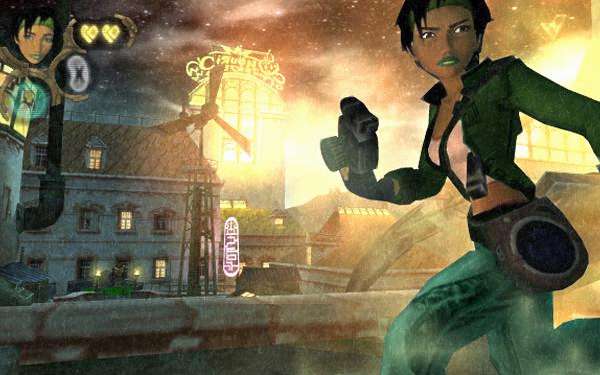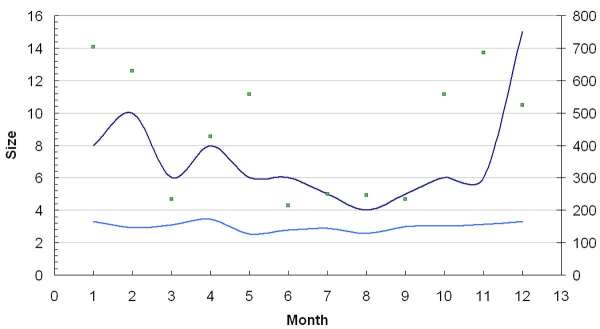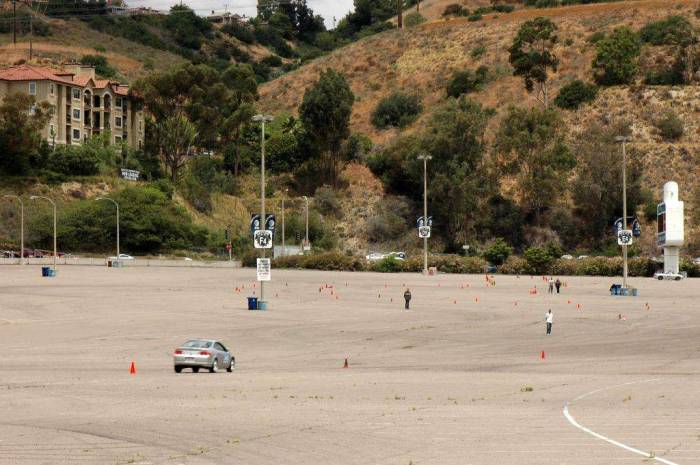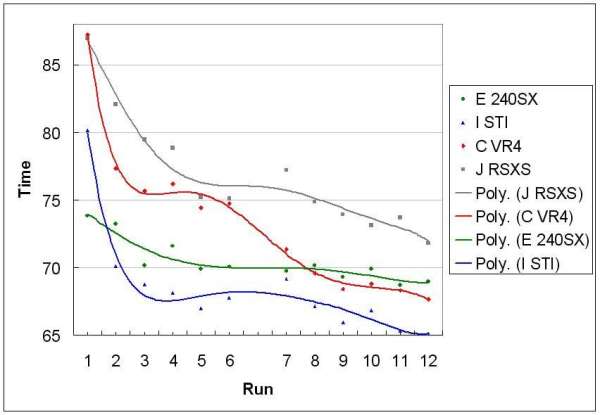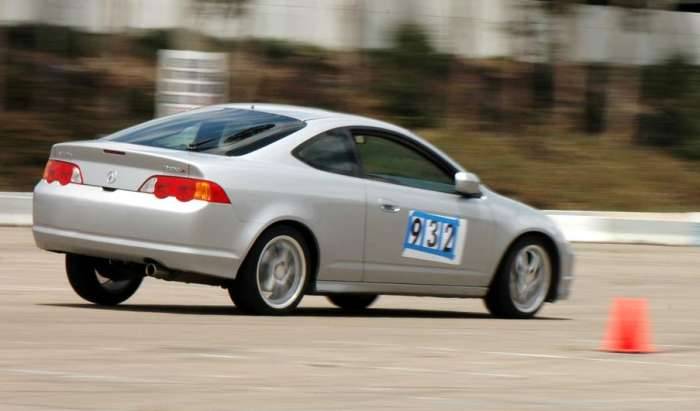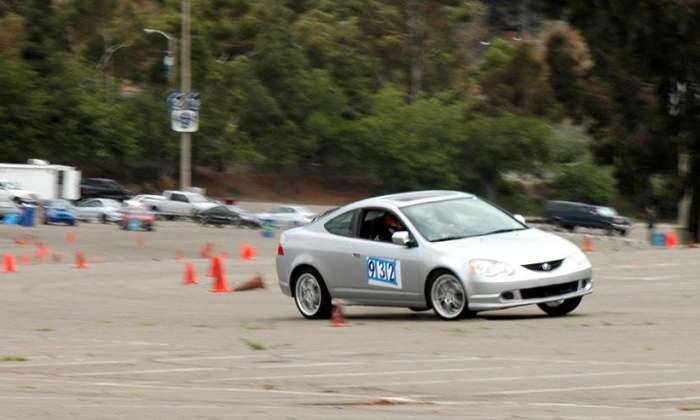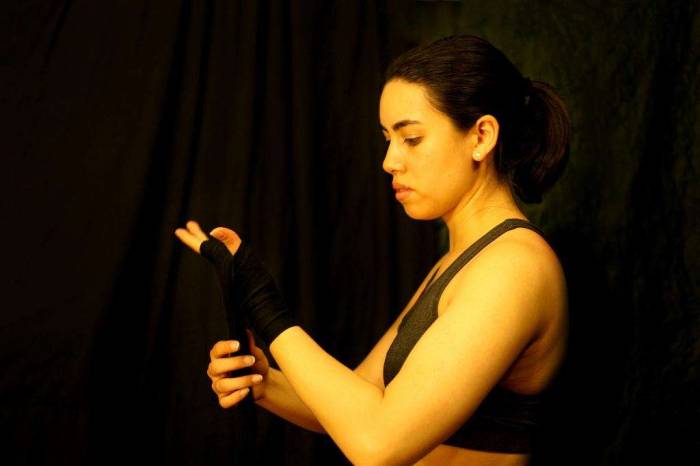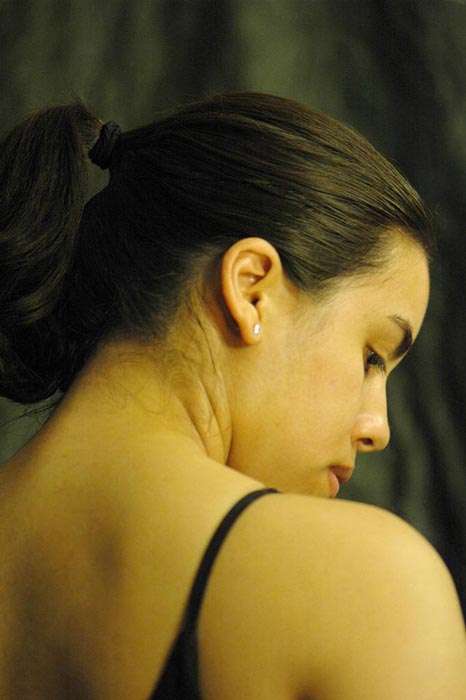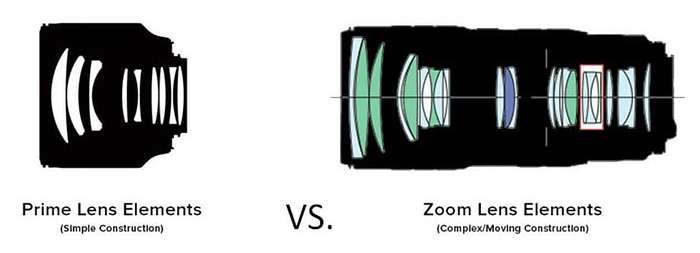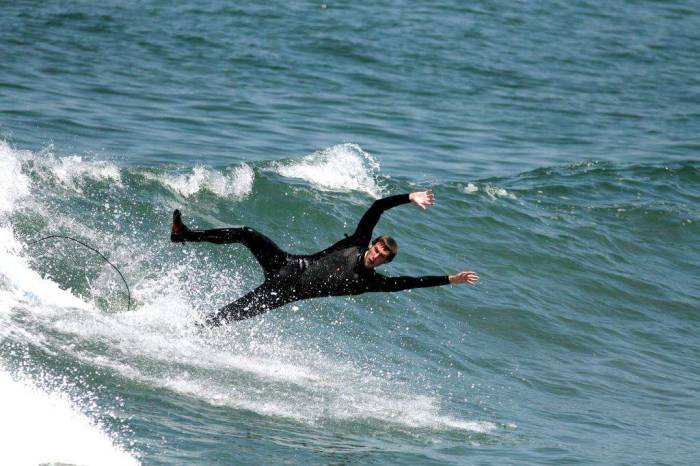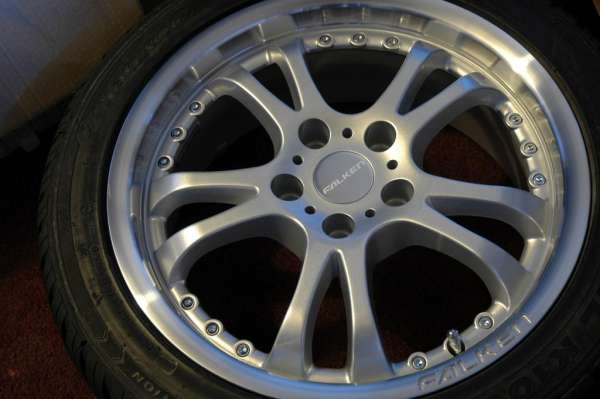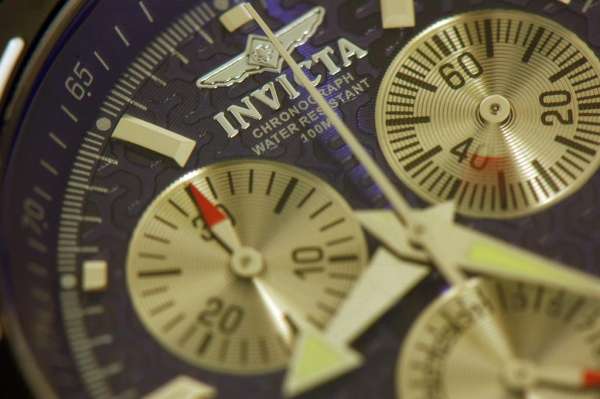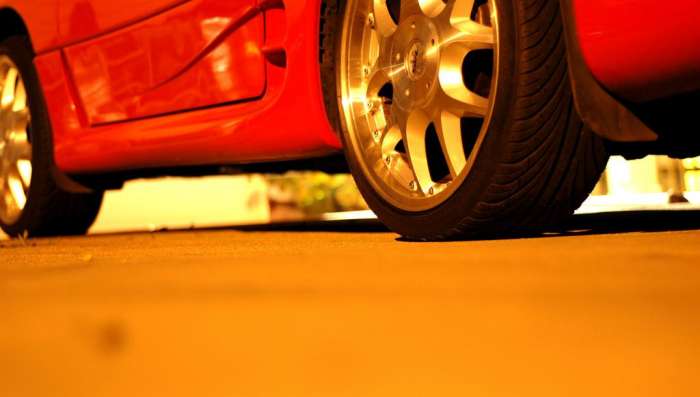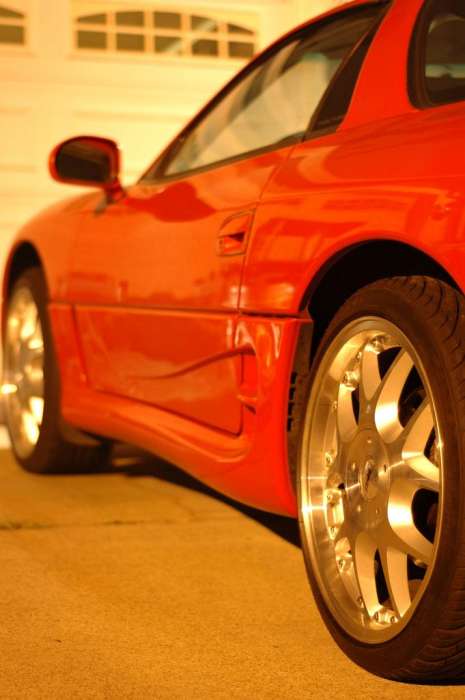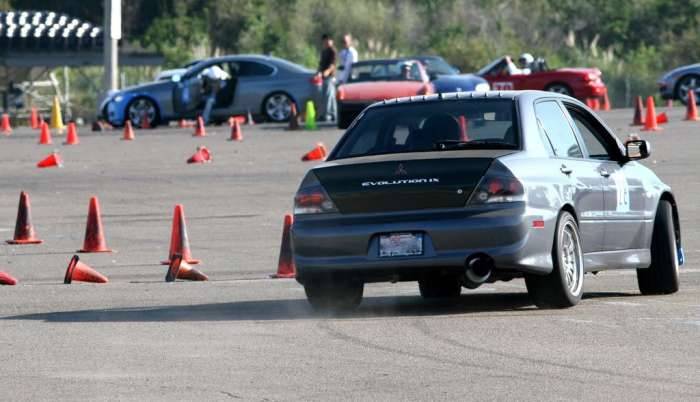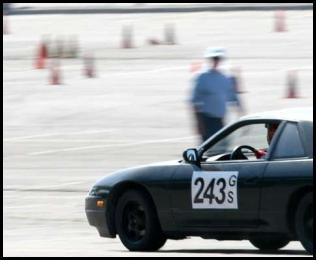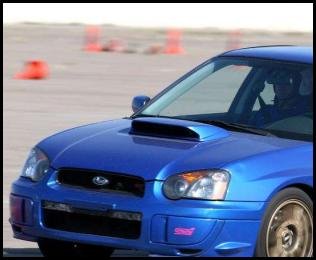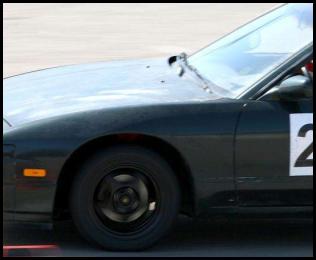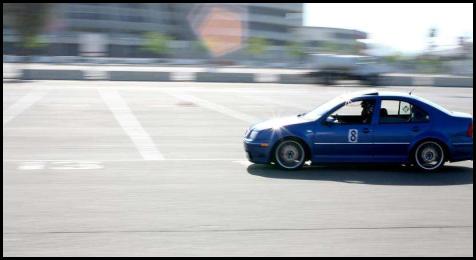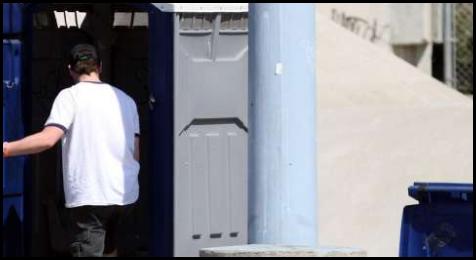|
Editorial | 2008.05.29
|
|
 |
 |
A follow up to the
prior discussion regarding photography equipmentt, quotes from
Connie throughout.

|
This weekend I was cursing myself for not having the point and shoot.
|
A point and shoot is, of course,
necessary equipment. Bringing it depends on the shoot but there are some distinct advantages:
- Size. They fit in a pocket or purse and are lightweight. They can get places professional equipment cannot.
- Versatility. They have a full range of exposure settings and focal lengths onboard.
- Discretion. Their prevalence means people will notice them much less than an slr. Be it concert bouncers or wary subjects, sometimes you need to keep a low profile.
- Price. They can be purchased and replaced cheaply. Some equipment, such as underwater housings, are a much better deal for these cameras.
- Video. Sometimes you want to shoot 640x480 video.
Of course drawbacks are obvious:
- Lower quality images. Small ccds, shoddy lenses.
- Less power. You're limited to the stock focal range, flash, etc. whereas slrs let you use fast lenses, tellies, flash controllers, etc.
- Discretion. You can't look like a pro shooting with an Elph. Be it nabbing photo passes or needing subjects who take you seriously, sometimes you need to flaunt the big lens.
- Lack of modularity. Photo equipment, like computers, shouldn't be upgraded in lockstep. Your body might need to be replaced every three years, your flash every five, your lenses never.Capturing the moment is more important than having ultra high quality, and this is what i realized this weekend. The essence of photography is capturing the moment. The ideal capture involves an h3d with twenty lens choices, fifty strobes, and two weeks to perfect the setup. Reality, however, reminds us that we'll never have the luxury and therefore must assess our constraints:
- Media. Are you shooting for a magazine? A photo exhibition? A class? A web site? Based on this you have to determine how many frames you need, who the audience is, how much scrutiny the images will be subjected to. Some of these Yosemite photos I want to enter in the fair, others are for the scrapbook. So some need to be set up very carefully, the others can really just snare the moment.
- Time. When is your deadline? For how long will your subjects be available and willing? Will you ever have the opportunity again? Will each frame be unique or can you take many shots with different setups? I go to Yosemite every year, but check out these awesome clouds. How am I going to compose with my friends hiking all the time?
- Equipment/budget. What equipment do you own? What can you bring? This is going to be a long hike. Better go light. Rain? There's no way I'm changing lenses.
- Skill. Photography is difficult to master. Maybe you dropped a few g's on an umbrella setup, that doesn't mean you can use it. I never learned proper fill flash, so I can leave that back at camp for the night shots.
- Style. You only have to shoot what you think looks good until you go pro and have to shoot what makes money. Oy vey not another photo of a squirrel. Yosemite only looks good through a red filter.
Bobby, who's always on the next level, only does point and shoot nowadays. Last I checked he did hipster photojournalism.

|
1. I could not sacrifice water or other things to carry more weight, hence, only had the 10-22mm wide angle lens and 50m prime. So many cute furry critters that I could not capture with my 10-22mm, nor could I swap out the lens for the 50m since by the time I did that the furry critter was gone. I was cursing myself for not having a larger focal length zoom. Then again, I was cursing myself for not having the point and shoot to capture the cuteness moment.
|
So your constraints are not having the optimal equipment nor the time to use it appropriately. Recognizing these constraints you have to start making concessions on quality. The next step down would be two cameras, two lenses, two bags. Budget constraint? Weight constraint?
Okay, one camera, zoom lens. Or crop the final photo. Weight constraint still? Resort to a point and shoot.

|
2. It didn't matter that I carried an extra lens, with the amount of rain falling, I could not switch out the lens. Rain... was horrible. I was too worried with protecting the camera than taking photos since even the camera bag was getting soaked through. When I did take the camera out for photos, there was no way of preventing the rain from getting onto the lens. I thought that darn, I should have bought a lens hood.
|
Rain makes photography difficult. In this case, a point and shoot would have suffered more for quality because water on the small lens creates much more distortion than on a 50+ mm lens. Of course, you'll care less about your point and shoot getting wet. Equipment such as tarps and housings can solve this, but sometimes you just have to say it's not worth it (or only worth losing a point and shoot).

|
3. When trekking with a group of people, it expends much energy to take a photo - there was fidgeting with the camera, wipe the water droplets off the lens, find a spot with least amount of water, etc. To compose a shot, taking the camera in and out of the camera bag (needed to protect it from the rain), and then run to catch up with the group. I just physically couldn't keep doing that, especially since time was an important factor on the hike. We needed to do the seventeen mile round trip in daylight.
|
That is completely true. I can empathize anecdotally. Shasta was pretty rough and it took all my will power to pull out the n80, frame, meter, shoot, and return it to safety. But I took some of my favorite shots up there, and so it was worth it. Also it was worth it because
Arthur had to wear sandals for the next three months.
You really have to
assess what you can carry and only pack what's reasonable. But don't be fooled,
you'll still have to go beyond your limit. One of the best ways to take unique photos is to carry an slr where few people can.
I'll loan you my copy of
Beyond Good and Evil. You can play it in on the Wii while you nurse your injuries. That'll learn ya. And I think between the strong female lead, photography, and cute animals you'll like it.

|
4. Bulkiness of the pack weight - even with prepping and working out an easy access camera carrying system with a backpack, it still weighed down my shoulders instead of my hips and physically it really hurt on the last six miles of the hike. Physically I just cannot carry so much weight and do a strenuous hike to carry extra camera gear.
|
Select one of the following:
a. You took too much equipment (photo gear or otherwise).
b. You're too girly... or not girly enough, 'Carry my pack for a while, pleeeease.'
Same as 3. It ain't easy. You have to make a guess as to how much equipment will make the trip suck, and how much will make it really suck. Sometimes you'll guess wrong.

|
5. Positioning, it's really hard to compose a shot while one is already balancing on the side of a slicked surface rock, on the edge of a cliff that could potentially be one's certain death, with the weight of a pack that throws your center of gravity off, and a line of hikers patiently waiting for you to finish taking a photo, and with rain constantly falling down on your lens, even as you quickly wipe away the drops to take a quick shot. Zoom at that moment is a great thing.
|
Personally I'd crop, but that's because I'd be worried about the rain getting inside the telescoping parts of my zoom lenses. I have a feeling your big ol' zoom wouldn't serve you well here in spite of it's large focal range. But yes, in planning the trip start with the h3d setup and work your way down to a disposable camera. You may decide to play it safe and use the zoom or point and shoot,
ultimately you'll know what was the best choice.
[This'll be a great place to compare your identical photos taken on various trips, send me some links].

|
The fact was that I was burdened with too many factors of physical fatigue, time factor, weather conditions, etc, that I could not take the photos that I wanted to, and, bottom line, I ended up having a few photos and only in spots where taking a photo was a viable option. All the good parts of the trip are now just left to memory.
|
Too bad memory is so fickle and subjective. So what's important here, quality or quantity? Of course you only do what you can, but
after this experience I think Zion will be much easier. Framing, lighting, and perspective are important photography skills, but so is being able to shoot in difficult situations. You always want to push your limits while keeping yourself and your equipment out of harm's way.

|
It doesn't matter how smart or athletic one is. Nature dominates and reminds one of their humble place; that we are at the mercy of the elements.
|
Connie: photographer, adventurer, aspiring National Geographic narrator
I ran a script on my wave height log to plot
mean and max set height (per Surfline) by month. The data goes back to mid-2006 and counts a few of the popular SD breaks (Blacks, Cardiff, etc.).
Dark blue is maximum set height. Light blue is average set height. The dots correspond to the right hand axis and represent the number of data points for that category.
I have a feeling the low data point count for June - September means there are a number of flat days that the script skips over. So the light blue line might actually be closer to one.
That aside, the mean
wave height doesn't change much by month. This is probably because the big days we get in December are offset by trashy days on account of wind.
Of course, if you're looking for the big days, look no further than December, February, and April.
For anyone interested in the
gaseofinancial impact of motorcycle ownership, here are the monthly gas expenses for the past couple years. They're normalized to $4/gallon based on average SD gas price for that month.
I did some quick and dirty averages, discounting May 2006 where 'froading added to the gas expenditure. Also I did not factor in December 2007 as it featured a road trip from Oregon to San Diego.
- Celica: $304/month
- Celica + Supersport: $165/month
- GTO + Supersport: $175/month
A few notes:
- The average expenditure figure for the Celica is based on just two months. These were months of job searching so with a regular commute the number might well have been higher.
- Celica averaged 27 mpg. GTO gets about 18. Supersport is near 40 on most fill ups.
- The normalization to $4/gallon provides a better perspective for averaging and comparison. But it should be noted that the differences would be greater in summer, also cheaper gas provided less of a disincentive for casual driving.
Never has shark-jumping been more punctuated. The new Indiana Jones movie is impressive until you see Shia LeBeouf straddling moving jeeps whilst sword fighting - looking very much like he's on water skis. From this scene on Lucas and Spielberg work their hardest to wreck the film.
Two particular action sequences are simply painful to watch - ostensibly on account of George Lucas's fascination with infusing humor into scenes of high drama. For a few moments you'll see a great deal of
Star Wars prequel in the film.
Spielberg also had a 1977 film he has now forced into the Indy series. And it's too bad. The plot point is obvious from the opening scene but throughout the movie you wonder if they can pull it off. Nope.
Other than that the movie is fantastic. The humor is clever and light-handed, the dialog circumvents the cheesy lines that seem impending. Oftentimes film cinematography makes too many concessions to appear either realistic or comic booky, not so here and it is a fine accomplishment.
If you're expecting the Ford-LeBeouf interaction to resemble Ewan McGregor and Hayden Christenson, thankfully that is not the case. The two play off each other very well and there aren't many 'omg they're so alike!!!' scenes.
The movie
carries the adventure elements that define the Indy series. But there are
two new themes that add complexity to the story. They're executed very well. The first and obvious one is age. It's not dismissed or cg-ed over. It's a prominent theme until Indy returns to his world- treasure hunting in the Amazon. The second element is injecting the 1930s adventurer into a world twenty years newer. These themes add humanity to the character who was always so surly and confident. It
serves as a great denouement to the series by illustrating that he is the last and greatest of his kind.
And then Shia jumps the shark.
|
Storypost | 2008.05.25
|
|
 |
 |
Yesterday was autocross.
I got a little sloppy on the charting. Oh well, it's all there. Getting so many runs was a real feather in our cap.
Jon was testing the limits of traction, or so I noticed when I rode with him. Sliding off course was a real black eye for me on the first two runs.
Erik peaked early, Ian improved until his tires stopped gripping. He's got some nasty chunks missing.
Most times were in the 63-65 range. The other SD SOLO photographer was happy with the 61 he ran in his rx8, a stock Vette managed a 56, and the karts were pulling low 50s.
Key lessons learned:
- Off camber corners are significant.
- Racier tire setups don't give much warning before breaking loose.
- Skillful driving and r-compounds are a good substitute for being short on power.
The results of the April event, for comparison.
White Lambda was definitely pushing the Ac around.
Yes folks, that wheel is off the ground.
I studioed the garage, tried to avoid flash to cut down on post-production background woes. I'm adding to the list of reasons I need a bigger garage.
|
Editorial | 2008.05.22
|
|
 |
Connie sent me the link to an
oped advocating zoom lenses. For the most part, I disagree. But some worthwhile points are made.
The author's two reasons for getting zoom are:

|
1. Cheaper; "By the way, if you are not under any specific budget restraints, ignore everything I said and buy that 600mm f/4."
|
Keep in mind that
lens technology won't change much. The focus speed and vibration reduction will get better - marginally. The optics leveled off in 1980, now they may fluctuate according to ROHM, weight, and meeting a target price. You'll need a new camera every few years, but
your lenses should survive quite a few bodies. Thus it is much more cost effective to buy an expensive lens. Yeah 10g's is a bit much, but when you're talking $1000 for a good lens versus $1500 for a great lens, spend the extra dough.

|
2. Laziness; "When I'm precariously balanced on a rock in a mountain stream, or at the edge of a cliff overlooking a great canyon (Zion canyon above), not having to change lenses to change focal length, or not having to move forward or backward physically to improve my composition is a real plus (puffins below)."
|
He's knowledgeable, but I'm not a fan of any of his shots. Yes, it's all aesthetics. But if he's complaining about the price of a 600mm or having to do the work of an assistant (fetch lenses), he isn't the creme de la creme. Indeed most pros don't change lenses, they change cameras (one lens per camera per assistant). You
shouldn't let extra weight dictate your lens choice unless it's going to affect your ability to get the job done.
And he goes on to
marginalize the prime benefits of speed, clarity, af speed, vr, minimum focus distance, etc. These can be hard to quantify and always depend on the subject/situation. But the bottom line is you always want the best equipment if it's feasible.
I grant there will be rare times that you will want a zoom lens because there's no time/space to change lenses. But think about the other 99% of your photographic life. Will THE ONE SHOT occur in this 1% or will it be in the other 99%? Could it be that in this other 99% you'll miss THE ONE SHOT because your focus was too slow? Because you paused to compose with zoom rather than snap on instinct?

|
When you don't have a lot of room, these lenses can be lifesavers. When you are hiking and trying to save weight this a great way to go.
|
Depends on the lens.
Weigh and size your zoom versus your 50mm and 35mm. Toss each against the wall to see which survives (but don't really). There are lots of factors to consider when you're going outdoorsing.
I'll tell you I did Shasta zoom was a good choice because space was at an absolute premium. And there was no way I was going to change lenses up there. The ideal setup would have been a 15-50mm.
More important than focal length, however, was aperture. An f/1.4 would have given so much more light in those early morning hours.
Bottom line:
- You only need one zoom lens, for the 30-120mm application. At sub-40 you generally want to get the smallest focal length available, so a sub-40 zoom will spend most of its time at minimum. At over 120 you generally want the largest focal length available. Seldom will there be a time that 200 is desirable and 300 is not.
- Maintain a nice quiver and take out the right equipment. If you're shooting studio you can bring the kitchen sink. If you're going on a dayhike you can take three or four lenses. If you're documenting civil unrest 30-80 might be your best bet.
| | | | |
|
|
Weight doesn't matter for something like a planned shoot where the distance of the subject is in a controlled environment. however, weight does matter for most cases with lens choice. In most instances a person can only carry one or two lenses.
|

Connie
|

Chris
|
For Shasta it was one lens. For a dayhike all I need is water, so I could carry my weight in lenses. There are lots of in betweens but I would say that in most instances a person can drive with ten lenses and carry three or four. And remember you can whittle down your choices of necessary lenses as you gather more information on the shoot.
|
|
|
And even if the person carries more, the time it takes to change out the lens for the right one result in missed opportunities.
|
|
Depends on the scenario. If you're doing landscapes or macro in the field you have plenty of time. If you're doing photojournalism of people you can use the 35 all day. You're stuck on this lens changing time. It shouldn't be more than twenty seconds (or two seconds to switch cameras).
|
|
|
For example, surfing in MB, even with the 300mm prime, I was limited in what I could shoot. I could not get the entire wave, only the surfer at the particular spot on the wave.
|
|
Not true, you could have switched out the 300mm at any point. But you didn't because waves are very wide and not very tall. Anything zoomed less than 300mm would have been boring. I'll grant people might be interested in one zoomed-out shot so they get an idea of what the day looked like. But that's it.
|
|
| | | | |
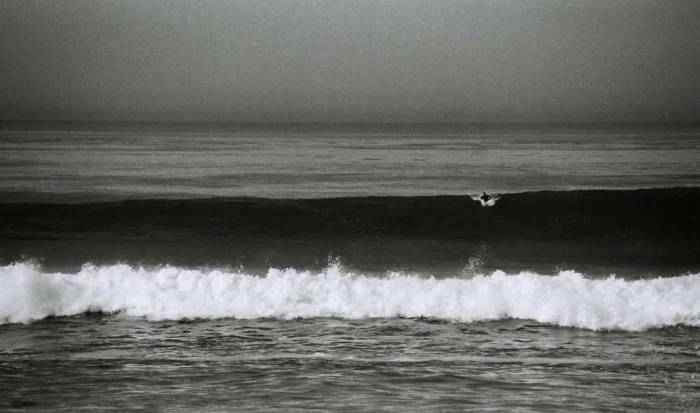
| | | | |

Chris
|
Also you're thinking like a zoomer. That's your new name, zoomer. The solution to getting a whole wave is not to zoom out. That means you end up with a very small subject and a lot of empty space outside the line. A primer would get down lower (yes it's dangerous) and shoot up the barrel (up the shoulder). That way you get the whole wave, don't waste space, have a clear, big shot of the surfer, and have the sweet depth of field effect down the line.
|
|
|
|
See what I mean when I say prime shooting encourages creativity?
|
|
|
|
Yes, I could have walked further south of the jetty, but in doing that I would miss out on a portion of shooting.
|

Connie
|
|
True, had you walked south into the water you would have missed out on a lot of shooting.
|
|
|
If I changed out my lens, I would miss out on the time to change lenses.
|
|
You missed plenty of shots gabbing with my mom. And that's fine, because there were a lot of waves and a lot of rides. You must realize that even if you have the right lens you still need to be aimed, timed (you had a lot that were just a moment too soon or late), and focused (some of these too).
|
|
|
As soon as you're holding the camera at the ready all the time, quick on the trigger, and perfect with the focus you can complain about how long it takes to change lenses. At that point I'll lend you my d70 to use as a secondary.
|
|
|
And what if there was an instantaneous shot that would be good to have both a far-view and a close-up view. I could not do that in one sitting.
|

Chris
|
Multiple bodies. And like I said, short of Mavs in winter, anything zoomed out is booooooooring.
|
|
|
THE ONE SHOT seems to be easier captured with a zoom.
|
|
Let's assume THE ONE SHOT is something photojournalistic, a once-in-a-lifetime scene that never occurs again (if it's in the studio or whatever, you have all the time and equipment you want). What's the most important thing? Timing. When you're snapping at a thousanth of a second, timing is everything. Composing with zoom will take you a second or two. At five frames/second that's five or ten shots that you just missed. For a once-in-a-lifetime occurance, your opportunity could be gone because you wanted to compose.
|
|
|
Sure cropping is a faux pas, but when you have a ten megapixel image, you can probably adjust your framing after the fact.
|
|
|
Let's say you're Solana shark shooting and you suddenly see him breach. Good example, you could sell it to Reuters for bank and it'll never happen again. It's virtually impossible to pan to him in time. But say you do. You don't have time to zoom, so you're better off without the temptation. Every millisecond spent not focusing means more frames - so here focus speed is key. Yes if you had a 1200mm lens there's a chance the frame would miss some important part of the scene. Doubtful. More likely, the less blue water around your frame, the more you'll see jagged teeth and piercing eyes.
|
|
|
Minor factors that could have impact would be lens speed and vibration reduction. For all of these factors prime lenses are superior to some extent.
|
|
|
Now back to the possibility that THE ONE SHOT is in a studio with all the time and equipment you want. What are your concerns? Sharpness? Low dof? Better vr? Focus speed? All these are characteristics of prime lenses. And keep in mind these factors stand out much more in a well-prepared studio shot.
|
|
|
I guess prime and zoom both have their purposes.
|

Connie
|

Chris
|
Yes, and you are all set on zoom with that fifteen pound monstrosity. You don't need twelve zoom lenses. You need one zoom lens and eleven prime lenses. And carry the ones that are appropriate.
|
|
| | | | |
|
Infopost | 2008.05.16
|
|
 |
Jon's
Falken Torque5s with
Hankook K106s came today. Now we just need his car.
- 16" -> 17"
- 205 -> 225
- All season -> performance summer
- No tread -> tread
A
105mm f/2.8g vr arrived today. It's almost time for Pizza Port and to kick Dan out of San Diego, but I squeezed off a few trial frames. Pretty good detail, no?
The watch is an Invicta Racing Chronograph.
|
Review | 2008.05.11
|
|
 |
Is it a shame I have new wheels and tires before
Jon? Yes. Will that be the case when his come in and they're shiny and scratch-free? No.
While I'm on the subject, here's my experience with
Edge Racing. I ordered some wheels and tires from
them since they advertised in
Grassroots and had good deals. I was surprised to not get a confirmation email immediately. I was surprised the order did not ship within 24 hours as advertised. I was surpised I didn't get an email explaining that the tires were on back order.
It wasn't until I called that I learned the tires were back ordered in spite of what the availablity quote indicated. I asked for expedited shipping to compensate for the delay, the csr declined. I asked for an order confirmation email, the csr said the 'order shipped' email was sufficient.
I'm the passive-aggressive type consumer who won't throw a fit, but instead pass the experience on to others and, naturally, never patronize them again.
Here's a report card of all my tire-related purchases. Since it's Corporate America, I believe the grade school rating system is appropriate.
Tire Rack (online) and
Les Schwab (in store) get
pluses for expediency, inventory accuracy, and complaint handling. (Tire Rack quickly replaced a strut I ordered that appeared to have been previously installed).
Edge Racing (online) gets a
check for expediency, inventory accuracy, and complaint handling. By contrast, Craigslist gets a plus for expediency and inventory accuracy, a check for complaint handling.
Price wise: Craigs < Edge < Tire Rack < Les Schwab
Back to the TSWs. I like them considerably more than the stock wheels and more than I thought I'd like them before mounting. They're still a bit shiny for a Japanese coupe but a good dose of brake dust will solve that. We'll see how the Falkens will stand up to autocross.
|
Storypost | 2008.05.04
|
|
 |
Erik and Ian did autocross training.






